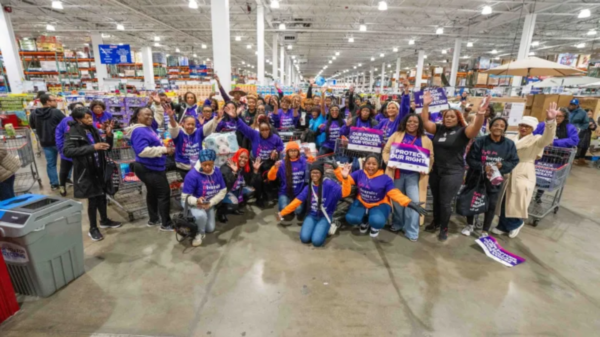By Amari Apple
Rolling Out
Reprinted – by Texas Metro News
https://rollingout.com/
November data reveals growing racial and gender disparities in employment

Market overview
November’s labor market data reveals a troubling shift in employment equity, with Black women facing a sharp increase in unemployment rates. While the U.S. unemployment rate overall saw a slight rise from 4.1% to 4.2%, deeper analysis by demographic highlights a widening gap, pointing to the need for targeted policy and support.
Critical statistics
The unemployment rate for Black women surged from 4.9% to 6% in November, a significant spike that outpaces other demographic groups. This sharp rise is particularly concerning as it contrasts with white women’s unemployment, which increased only marginally from 3.3% to 3.4%. Such disparities underscore persistent inequalities in employment opportunities that have broader social and economic implications.
The recent numbers suggest that this isn’t just a temporary setback but part of an ongoing trend affecting Black women more acutely than other groups. This increase is stark when considering that the overall unemployment rate, though inching upward, does not reflect the same level of strain experienced by Black women.
Broader demographic patterns
The issues faced by Black women reflect a broader trend impacting the Black workforce as a whole. The overall unemployment rate for Black workers rose to 6.4% in November from 5.7% the previous month, signaling deeper challenges. Black men continued to face a 6% unemployment rate, a figure that has remained relatively stagnant, while white men saw a steady 3.5% rate. The persistent racial disparities in these figures illustrate the unequal stability of the job market across different communities.
Such figures are emblematic of the economic inequities that affect not only employment prospects but also income and long-term wealth-building opportunities for Black communities.
Labor force participation
Labor force participation rates further emphasize the widening gap. The overall U.S. participation rate fell to 62.5%, continuing a slow downward trend. However, Black women’s participation rate dipped to 62.3% from 62.6%, while Black men’s participation fell to 68.7% from 69.3%.
These figures reveal a concerning pattern: more Black workers, particularly Black women, are becoming disconnected from the labor market. This trend hints at systemic challenges that extend beyond job availability to issues like workforce accessibility, job quality, and career advancement opportunities. The decline in participation suggests that, for some Black workers, the barriers to entry or continued engagement in the workforce are becoming more pronounced.
Market cooling effects
The data points to a cooling of the labor market, a trend that has been impacting workers across demographic lines but has disproportionately affected marginalized groups. This shift marks a departure from the immediate post-pandemic period, when employment opportunities were more plentiful and equitable. The economic environment now presents challenges that exacerbate pre-existing disparities and may indicate an upcoming period of heightened competition for jobs.
The cooling labor market could mean that those who are already marginalized face longer periods of unemployment and fewer opportunities for upward mobility. For Black women, whose unemployment rate is notably higher, this could mean sustained economic strain.
Hispanic worker impact
The effects of a cooling labor market extend to other minority groups as well. Hispanic men, for example, saw their unemployment rate rise from 4% to 4.4% in November. While this increase is not as pronounced as the surge for Black women, it still highlights that the broader trend is impacting many minority communities.
These numbers suggest that while progress had been made in the past decade in addressing employment disparities, there are now signs of stalling or regression. The intersections of race, gender, and ethnicity mean that certain groups face compounded challenges when navigating employment landscapes.
Historical context
By historical standards, the unemployment rates remain relatively low, which is an important note. Yet, these figures do not diminish the concerns raised by the specific increases seen among Black women and other minority groups. The post-pandemic recovery had shown initial promise in offering more equitable access to jobs and economic stability. However, the recent data signals a potential reversal in that progress.
The figures suggest that the recent rise in unemployment for Black women may be a symptom of larger structural issues that require targeted intervention. Policymakers, businesses, and communities need to understand that these disparities are not just about a jobless rate but about the systemic barriers that perpetuate economic inequality.
Future implications
The trends outlined raise questions about the future of employment equity and what steps are necessary to bridge these gaps. Targeted interventions focused on job training, educational programs, and employer incentives to promote diversity in hiring may be critical to reversing the recent increases in unemployment rates.
Policymakers must prioritize job creation strategies that support marginalized communities and address disparities in job access. Initiatives that aim to bolster economic resilience for Black women and other underserved groups could play an essential role in preventing further long-term economic impacts.
In conclusion, while the labor market as a whole faces a cooling period, the disproportionate effects on Black women highlight the need for a renewed focus on employment equity. Through concerted efforts that address systemic issues and promote inclusive economic policies, we can hope to create a more equitable job market where all groups have the opportunity to thrive.








You must be logged in to post a comment Login